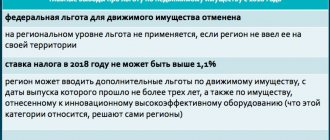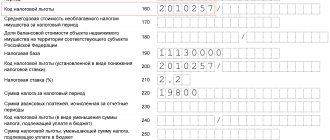What is movable property
The difference between movable and immovable property is outlined in Article 130 of the Civil Code.
It says that real estate is plots of subsoil and land, as well as everything that is firmly connected to the land. An explanation is also given here: objects are considered firmly connected to the ground, the movement of which is impossible without disproportionate damage to their purpose (in particular, buildings, structures, unfinished construction). In addition, real estate includes aircraft and sea vessels subject to state registration, space objects and inland navigation vessels. Movable property is things that are not recognized as immovable. Movable property includes, in particular, money and securities. In general, registration of rights to movable property is not required.
Unfortunately, the definition of movable property is very vague. Therefore, it is not completely clear which movable things are exempt from property tax in accordance with subparagraph 8 of paragraph 4 of Article 374 of the Tax Code of the Russian Federation. Let us consider separately the objects that most often raise questions among accountants (hereinafter we are talking about property put on the balance sheet from January 1, 2013).
Movable property is not recognized as an object of taxation.
In accordance with paragraphs. 8 clause 4 art. 374 of the Tax Code of the Russian Federation, from January 1, 2013, movable property registered as fixed assets is not subject to property tax for organizations. Movable property is all office equipment, cars, equipment, furniture of the organization, etc. This provision applies to movable property registered starting from January 1, 2013. All movable property that was registered earlier than this date will continue to be subject to taxation until its original cost is completely written off in accounting, or until sale (other disposal).
It should be noted that organizations are required to timely take into account fixed assets and reflect them on balance sheet accounts 01 “Fixed Assets” and 03 “Profitable Investments in Material Assets”.
NEW PROCEDURE FOR PAYING PROPERTY TAX ON MOVABLE PROPERTY
In accordance with Order of the Ministry of Finance of the Russian Federation dated October 31, 2000 N 94n (as amended on November 8, 2010) “On approval of the Chart of Accounts for accounting financial and economic activities of organizations and Instructions for its application,” the balance on account 08 “Investments in non-current assets” can only reflect the amount of the organization’s investments in construction in progress, unfinished transactions for the acquisition of fixed assets, intangible and other non-current assets.
Thus, movable property items that do not require installation must be put into operation immediately after their acquisition. If for objective reasons this does not happen, the organization must have primary documents that provide a clear list of work to prepare the facility for use.
From 2013, all movable property of an organization will be divided into those that are subject to property tax and those that are not subject to taxation. It is advisable to open two sub-accounts for movable property accounts: for objects registered before 2013, and for objects registered after 2013.
ACCOUNTING SERVICES, PRICE
Primary documents confirming the moment of acceptance of movable property for accounting may be acts of acceptance - transfer of fixed assets and inventory cards. The organization must develop these documents independently and approve them in its accounting policies for 2013.
It should be noted that organizations can approve in their accounting policies the unified forms N OS-1 “Act of acceptance and transfer of fixed assets (except buildings, structures)” and N OS-6 “Inventory card for recording fixed assets” previously adopted by the State Statistics Committee of the Russian Federation. (Resolution of the State Statistics Committee of the Russian Federation dated January 21, 2003 N 7 “On approval of unified forms of primary accounting documentation for accounting of fixed assets”).
TAXATION OF SERVICES OF A FOREIGN ORGANIZATION FROM A RUSSIAN CONTRACTOR
Water supply, sewerage, electrical network and cable communication lines
Perhaps the most controversial objects are communication networks laid in buildings. At first glance, it may seem that they belong to movable property, and, as a result, fall under the benefit. Indeed, sewerage, as well as water and electricity networks, although located in the room, are only part of it. In addition, state registration of communication networks is not required.
However, such objects are real estate. The fact is that, according to the definition given in Federal Law No. 384-FZ dated December 30, 2009*, a building is a single volumetric system, which, among other things, includes engineering support systems. It turns out that the water, gas and electricity supply networks, sewerage, heating batteries and elevators are functionally connected to the building, and their movement would cause disproportionate damage to it. This means that these objects are immovable, and they are subject to property tax. This point of view was expressed by the Russian Ministry of Finance in letter dated August 15, 2013 No. 03-04-06/33238 (see “The Ministry of Finance recalled which fixed assets are classified as real estate for the purpose of paying property tax”).
But cable communication lines are classified as movable objects. This conclusion follows from paragraph 5 of the Decree of the Government of the Russian Federation dated February 11, 2005 No. 68 “On the peculiarities of state registration of ownership and other proprietary rights to line-cable communication structures.” It states that engineering infrastructure facilities created or adapted for the placement of communication cables are subject to state registration. These are cable ducts, above-ground and underground structures, as well as cable crossings.
As for the cable lines themselves, they do not need to be registered. Therefore, they are movable objects and the benefit applies to them. This is stated in the letter of the Ministry of Finance of Russia dated March 27, 2013 No. 03-05-05-01/9648 (see “Organizations have the right not to pay property tax in relation to cable communication lines registered on January 1, 2013”).
Alarm systems, air conditioners, advertising structures, ATMs and payment terminals
The application of benefits for air conditioning and alarm systems (both fire and security) depends on whether they are an integral part of the engineering support system. Simply put, are they built into the building during its construction, or are they installed later as separate objects.
If air conditioners are built into the walls and represent a single ventilation system of the building, then they belong to real estate and are subject to tax. The same applies to the alarm system, which is part of the building’s unified engineering and technical system. But if the above objects are independent and can be dismantled without damaging the building, then these are movable fixed assets. They can be excluded from the property tax base.
With ATMs, payment terminals and advertising structures, the situation is even simpler. They are a priori independent objects, and benefits can be applied to them without any reservations. Experts from the Ministry of Finance of Russia came to such conclusions in letter dated April 11, 2013 No. 03-05-05-01/11960 (see “The cost of separable improvements in leased premises registered after January 1, 2013 is not subject to property tax”) .
Changes to Chapter 30 of the Tax Code of the Russian Federation.
From January 1, 2014, the procedure for calculating property tax in relation to real estate has changed. Corresponding changes were made to Chapter. 30 “Property tax of organizations” of the Tax Code of the Russian Federation by Federal Law of November 2, 2013 N 307-FZ “On Amendments to Article 12 of Part One and Chapter 30 of Part Two of the Tax Code of the Russian Federation.”
Russian organizations
Until 2014, the tax base for property tax on all fixed assets subject to taxation was determined as their average annual cost (clause 1 of Article 375 of the Tax Code of the Russian Federation). To calculate the average annual cost, the residual value of fixed assets is used based on the organization’s accounting data (clause 3 of Article 375 of the Tax Code of the Russian Federation). Starting from 2014, the tax base for individual real estate objects is determined in a special manner established by Art. 378.2, which supplemented Ch. 30 Tax Code of the Russian Federation. The above applies to:
- administrative and business centers and shopping centers (complexes) and premises in them;
- non-residential premises intended for offices, retail facilities, public catering and consumer services, or actually used for these purposes.
To calculate property tax on designated objects, their cadastral value is used. The transition to calculating the tax base based on the cadastral value of real estate is irreversible. If a constituent entity of the Russian Federation has adopted a law on calculating property tax on individual real estate objects of a Russian organization based on cadastral value, then it is impossible to use the average annual value of the property when calculating property tax (Clause 2 of Article 378.2 of the Tax Code of the Russian Federation).
Foreign organizations
Payers of property tax are not only Russian organizations, but also foreign organizations that have permanent representative offices on the territory of the Russian Federation; foreign organizations that do not have a permanent representative office in the Russian Federation, but own real estate on its territory (clauses 2 and 3 of Article 374 of the Tax Code of the Russian Federation).
In the first case, the object of taxation is movable and immovable property, which is classified as fixed assets according to accounting rules (clause 2 of Article 374 of the Tax Code of the Russian Federation). At the same time, movable property registered after January 1, 2013 is not subject to taxation (clause 8, clause 4, article 374 of the Tax Code of the Russian Federation).
To calculate property tax, a foreign organization must keep accounting records of fixed assets according to Russian rules (paragraph 2, clause 2, article 374 of the Tax Code of the Russian Federation), therefore the object of taxation for a foreign organization that has a permanent representative office on the territory of the Russian Federation is determined in the same way as and from Russian organizations.
The tax base for property tax is calculated:
- for movable and immovable property that relates to the activities of a permanent establishment - as the average annual value of real estate (clause 1 of Article 375 of the Tax Code of the Russian Federation);
- for real estate of a foreign organization that does not relate to the activities of a permanent representative office - as the inventory value of real estate objects of these technical inventory bodies as of January 1 of the year for which it is calculated (clause 2 of Article 375 of the Tax Code of the Russian Federation).
In the second case, an object of taxation for a foreign organization arises only if it has real estate on the territory of the Russian Federation (clause 3 of Article 374 of the Tax Code of the Russian Federation). The tax base for property tax in this case is the inventory value of real estate as of January 1 of the reporting year (clause 2 of Article 375 of the Tax Code of the Russian Federation, clause 5 of Article 376 of the Tax Code of the Russian Federation).
Bodies for technical inventory of real estate objects are required to report information about their inventory value to the tax inspectorate at the location of these objects (paragraph 2, paragraph 2, article 375 of the Tax Code of the Russian Federation). They are not required to provide the necessary information to a foreign organization. A foreign organization must independently contact them for information to calculate the tax base.
This procedure was in effect until January 1, 2014.
From January 1, 2014, the tax base will be the cadastral value of:
- on real estate objects of foreign organizations that do not operate in the Russian Federation through permanent representative offices;
- for real estate objects that do not relate to the activities of foreign organizations in the Russian Federation through permanent representative offices.
If the cadastral value for the specified real estate objects of a foreign organization as of January 1, 2014 has not been determined, then the tax base for them is considered equal to zero (clause 14 of Article 378.2 of the Tax Code of the Russian Federation).
Determination of the cadastral value of real estate objects
In order to switch to a new procedure for calculating property tax, the authorities of a constituent entity of the Russian Federation must first approve the results of assessing the cadastral value of real estate objects, the property tax for which is determined as cadastral value, and only after that the law of the constituent entity of the Russian Federation must establish the specifics of the definition tax base for the property tax of organizations on these objects (clause 2 of article 378.2 of the Tax Code of the Russian Federation).
The list of real estate objects for which the tax base is determined in accordance with the new rules is approved annually no later than January 1 by the authorized executive body of the constituent entity of the Russian Federation and is posted on the Internet (clause 7 of Article 378.2 of the Tax Code of the Russian Federation). This list is sent in electronic form to the tax authorities at the location of the real estate.
If during the year objects are identified that were not included in the list, then they are subject to inclusion in the list approved by the executive authority of the constituent entity of the Russian Federation for the next year (clause 10 of Article 378.2 of the Tax Code of the Russian Federation). The tax base for property tax on such objects is determined in the same manner, i.e. as the average annual value of property (clause 2, clause 12, article 378.2 of the Tax Code of the Russian Federation).
If the cadastral value of only the building, but not the premises located in it, is determined, then the tax base for these premises will be calculated as the cadastral value of the building multiplied by the share of the premises' area in the total area of the building (clause 6 of Article 378.2 of the Tax Code of the Russian Federation).
Property tax rate and tax calculation
The law of the constituent entity of the Russian Federation must establish tax rates that apply to the tax base, determined in the form of the cadastral value of objects. They cannot exceed the following values:
- for Moscow: in 2014 - 1.5%; in 2015 - 1.7%; from 2021 - 2%;
- for other constituent entities of the Russian Federation: in 2014 - 1%; in 2015 - 1.5%; from 2021 - 2%.
The property tax for the year in relation to the specified real estate objects is calculated as the product of the tax rate in force in the territory of the corresponding constituent entity of the Russian Federation in which this property is located and their cadastral value (clause 13 of Article 378.2 of the Tax Code of the Russian Federation). Based on the results of the reporting period, advance payments for property tax are calculated as 1/4 of the cadastral value of this object (clause 1, clause 12, article 378.2 of the Tax Code of the Russian Federation).
The calculated tax is paid to the budget at the location of each of the real estate objects (clause 13 of Article 378.2 of the Tax Code of the Russian Federation).
Vehicles
With cars and other transport everything is very clear. They fully satisfy the definition of movable property given in Article 130 of the Civil Code. The only exceptions are aircraft, space rockets and watercraft that are subject to state registration. But most companies do not have such objects on their balance sheets, and never will.
All other vehicles are not subject to property tax. This was confirmed by the Federal Tax Service of Russia in a letter dated 02.18.13 No. BS-4-11 / [email protected] (see “Vehicles accepted on the balance sheet as fixed assets before January 1, 2013 are subject to property tax”).
Improvements in the rented premises
Many tenants, at their own expense, improve the premises they rent from the landlord. In some cases, such improvements are included in the tenant’s property tax base, in other cases they are not. It all depends on whether the improvements are separable or inseparable.
If the improvements are separable, they can be moved or disassembled without causing damage to the building. In such a situation, improvements are recognized as movable fixed assets and are not subject to property tax. This was emphasized by the Russian Ministry of Finance in letter dated 04/11/13 No. 03-05-05-01/11960.
Inseparable improvements are capital investments in the leased premises. The money spent on such investments is included in the initial cost of the premises. This follows from the provisions of PBU 6/01 “Accounting for fixed assets”. This means that inseparable improvements are inextricably linked with the building, and they should be classified as immovable objects. As a result, the tenant is required to pay property taxes on such properties throughout the lease term.
True, taxpayers do not always agree with this approach. You can hear the opinion that inseparable improvements, along with separable ones, are excluded from the taxable base. As confirmation, the following argument is given - the tenant is not the owner of the improvements. For this reason, he is deprived of the opportunity to register with the Federal Tax Service at the location of the leased property and submit a property tax return. But the Ministry of Finance of Russia, in letter dated 03.14.13 No. 03-05-05-01/7760, stated that such a point of view is erroneous, and there is no need to be guided by it (see “The cost of inseparable improvements to leased property, as before, is subject to tax on property").
Leased items and objects intended for rent
Exemption from property tax provided for in subparagraph 8 of paragraph 4 of Article 374 of the Tax Code of the Russian Federation applies to movable objects leased. Either the lessor or the lessee has the right to take advantage of the benefit, depending on whose balance sheet the fixed asset is recorded on.
Let us remind you that the question of who will put the leased asset on their balance sheet is decided by the lessor and the lessee. This is stated in paragraph 1 of Article 31 of the Federal Law of October 29, 1998 No. 164-FZ “On financial lease (leasing).” And if the movable asset ends up on the lessor’s balance sheet, then he will not have to pay property tax. The same applies to the lessee. The Ministry of Finance of Russia agreed with this approach in letter dated September 11, 2013 No. 03-05-05-01/37418 (see “Movable property recorded on the balance sheet of the lessor or lessee from January 1, 2013 as fixed assets is not subject to property tax” ).
The benefit also includes movable property intended to be provided for temporary use for a fee. This property is classified as fixed assets and is reflected in accounting as profitable investments in tangible assets (clause 5 of PBU 6/01). And since this is a fixed asset, then all the rules provided for OS are valid for it, including tax exemption. This is stated in the letter of the Ministry of Finance of Russia dated August 15, 2013 No. 03-05-05-01/33164 (see “Movable property that was acquired after January 1, 2013 for subsequent lease is not subject to property tax”).
Changes in property tax since 2013
Note:
* Read more about the amendments made to the Tax Code of the Russian Federation by Federal Law No. 202-FZ of November 29, 2012 and relating to transport and land taxes, as well as other laws that introduce changes to the procedure for calculating profit tax, VAT, excise taxes, mineral extraction tax and state duty in 2013, read in No. 2 (February) “BUKH.1S” for 2013, p. 9.
Federal Law No. 202-FZ dated November 29, 2012 (hereinafter referred to as Law No. 202-FZ) amended Chapter 30 “Organizational Property Tax” of the Tax Code of the Russian Federation, which entered into force on January 1, 2013.
Property received during reorganization or as a contribution to the authorized capital
After reorganization in the form of merger, the successor company inherits the property previously owned by the predecessor. And if this property is movable, then the legal successor receives an exemption from tax in relation to this object. Such comments are contained in the letter of the Ministry of Finance of Russia dated 08/05/13 No. 03-05-05-01/31412 (see “Movable property received after January 1, 2013 as a result of the reorganization of a company in the form of a merger is not subject to property tax”). The situation is similar with movable assets that were received by a company formed as a result of a spin-off (letter of the Ministry of Finance of Russia dated September 25, 2013 No. 03-05-05-01/39723, see “Movable property of a company spun off as a result of reorganization, recorded on the balance sheet in 2013, not subject to property tax").
In addition, a commercial company created by transformation from a unitary enterprise is entitled to the benefit. If a newly created organization received movable objects from a state unitary enterprise or municipal unitary enterprise, then it has the right to exclude them from the taxable base for property tax. This was explained by specialists from the Ministry of Finance of Russia in a letter dated 04/03/13 No. 03-05-05-01/10876 (see “An LLC created in 2013 as a result of the privatization of a state-owned enterprise can take advantage of an exemption from property tax in relation to movable property”).
In addition, movable fixed assets that the founder contributed as a contribution to the authorized capital are exempt from property tax. This conclusion follows from the letter of the Ministry of Finance of Russia dated May 29, 2013 No. 03-05-05-01/19527 (see “Movable property received as a contribution to the authorized capital and registered in 2013 is not subject to property tax”) .
Movable property tax 2015-2016
1) On the issue of submitting a property tax return:
Let's assume that you are entitled to a tax exemption on a certain category (or all) of your property. Then, when calculating the amount of tax payable, it is necessary to subtract the average annual value of the preferential property from the average annual value of taxable property. This follows from Sect. V The procedure for filling out the declaration.
The average annual value of preferential property is calculated in the same way as the average annual value of all taxable property.
The values of the residual value of all preferential property are reflected in lines 020 - 140, column 4 of part “Data for calculating the average annual value of property for the tax period” section. 2 tax returns. And the average annual cost is indicated on line 170 of section. 2 tax returns.
The rounded difference between the average annual value of all taxable property and the average annual value of preferential property must be reflected on line 190 of section. 2 tax declaration (clause 2.2, clause 8, clause 5.3 of the Procedure for filling out the declaration).
For each benefit category, you calculate the average annual cost of the relevant property separately. After all, for each benefit you need to fill out a separate section. 2 tax returns. Basis - clause 5.2 section. V The procedure for filling out the declaration.
From the literal interpretation of this norm, it follows that you must fill out a separate section. 2 for benefited property, even if you apply only one benefit.
At the same time, the tax authorities explain that a separate section. 2 must be filled out only when applying two or more benefits in the form of exemption of property from taxation (Letter of the Federal Tax Service of Russia dated 05.08.2008 N 3-3-06 / [email protected] ).
If your declaration includes more than one section. 2, then in the second and subsequent sheets of section. 2, the indicators in columns 3 and 4 will be the same, since these sheets reflect only the value of the property for which the benefit applies. Therefore, the value of the line is 150 sec. 2 of the tax return for preferential property will be equal to the value of line 170, and the indicator of line 190 of this section. 2 will always be zero. This is the procedure for filling out section. 2 declarations are confirmed by Letter of the Federal Tax Service of Russia dated 05.08.2008 N 3-3-06/ [email protected]
Tax Guide. Practical guide to corporate property tax {ConsultantPlus}
2) From January 1, 2015, in relation to fixed assets included in the first or second depreciation group in accordance with the Classification of fixed assets approved by the Government of the Russian Federation, one should be guided by subparagraph 8 of paragraph 4 of Article 374 of the Tax Code of the Russian Federation (hereinafter referred to as the Code), in accordance with which such fixed assets are not recognized as an object of taxation for corporate property tax, regardless of the date of their registration as fixed assets and transfer (including acquisition) between persons recognized (not recognized) as interdependent in accordance with paragraph 2 of Article 105.1 of the Code.
On the issue of taxation from January 1, 2015 of movable property included in other depreciation groups in accordance with the Classification, registered from January 1, 2013 as fixed assets, one should be guided by paragraph 25 of Article 381 of the Code, according to which such property is not subject to taxation , with the exception of movable property items registered as a result of: reorganization or liquidation of legal entities; transfer, including acquisition, of property between persons recognized as interdependent in accordance with the provisions of paragraph 2 of Article 105.1 of the Code.
Thus, movable property acquired for a fee from an organization, included in other depreciation groups and registered on January 1, 2015 as fixed assets, is not subject to taxation in accordance with paragraph 25 of Article 381 of the Code, with the exception of movable property acquired in interdependent persons.
{Question: About the property tax of organizations in relation to movable property acquired and registered as fixed assets from 01/01/2015. (Letter of the Ministry of Finance of Russia dated May 27, 2016 N 03-05-05-01/30592) {ConsultantPlus}}
3) At the same time, please note that movable property (including a car) acquired by an organization in 2021 and accounted for as fixed assets is not subject to corporate property tax in accordance with paragraph 25 of Article 381 of the Code (except for cases of acquisition from related parties or as a result of reorganization). <…>
{Question: About accounting for the costs of installing a built-in air conditioner in a car for the purposes of income tax and corporate property tax. (Letter of the Ministry of Finance of Russia dated November 18, 2016 N 03-03-06/1/67863) {ConsultantPlus}}
4) When filling out the “balance sheet” section of your 2021 return, you need to follow simple rules. On the first day of each month (from January to December) included in the tax period, we determine the residual value of the fixed assets and, separately, the residual value of the preferential property. We enter the relevant data in columns 3 and 4 of lines 120 - 140 of section 2. On line 141, from the residual value of all property, we select the residual value of the real estate.
The average annual value of the property must be indicated on line 150. This indicator is calculated simply: the values of column 3 of lines 120 - 140 are added up and divided by 13. This is the tax base. Now all that remains is to multiply it by the tax rate, and we will get the calculated tax amount.
At the same time, Section 2 also indicates the amount of calculated advance tax payments (if, of course, the law of the constituent entity of the Russian Federation establishes tax reporting periods). After all, at the end of the year, the tax payable is determined as the difference between the annual tax amount and advance payments.
Note! In line 270 of Section 2, you must indicate the residual value of all fixed assets of the organization, except for land. Accordingly, this indicator will be the same in all completed sections 2 of the declaration.
When filling out the “balance sheet” section 2 of the declaration, it is necessary to take into account that movable property of the first and second depreciation groups is not subject to property tax, regardless of when it was acquired. As for the “movable property” of other depreciation groups, it is exempt from taxation provided that it is registered as fixed assets from January 1, 2013 and later (see letter of the Ministry of Finance dated November 18, 2021 N 03-03-06/1 /67863). However, this benefit does not apply to objects that are included on the balance sheet as a result of the reorganization or liquidation of an organization (see letter of the Ministry of Finance dated December 23, 2021 N 03-05-05-01/77572) or as a result of a transaction between related parties ( see letter of the Ministry of Finance dated December 23, 2021 N 03-05-05-01/77567).
At the same time, the Ministry of Finance in a letter dated November 24, 2021 N 03-05-05-01/69448 and dated November 24, 2021 N 03-05-05-01/69457 explained that the tax benefit under paragraph 25 of Article 381 of the Code applies to movable property (inventory object) accepted for accounting as part of the OS from January 1, 2013, created (constructed) and requiring installation, acquired from a non-dependent person, regardless of which person (interdependent or non-interdependent) installed the equipment and from which person the components and materials were purchased. That is, if an organization acquired “movable property” from a third-party company, but purchased spare parts for it from an interdependent person (or an interdependent organization installed it), it does not lose the right to a benefit in the form of tax exemption for this property.
And one moment. Organizations may well acquire movable property through commission agents. In such situations, for the purpose of applying the tax exemption benefit, it is important that the buyer and supplier are independent entities. And what kind of relationship she has with the commission agent (whether he is interdependent with her or not) does not matter in this case. This was confirmed by the Ministry of Finance in a letter dated November 3, 2021 N 03-05-05-01/64423).
For your information! If the constituent entities of the Russian Federation, by their regional law, do not introduce a benefit in the form of exemption from taxation of movable property registered as fixed assets on January 1, 2013, it will no longer be valid from January 1, 2021 (Article 381.1 of the Tax Code). <…>
Article: Property tax declaration for 2021: “basic” problems and solutions (Remchukov S.) (“Express Accounting Newsletter”, 2021, N {ConsultantPlus}
{ConsultantPlus}
5)… other (from groups 3 - 10) movable property registered after 01/01/2013. Since 2015, such property has been subject to preferential treatment; information about such property must be reflected in the declaration.
The Federal Tax Service of Russia in Letter dated December 17, 2014 N BS-4-11/ [email protected] explained that when filling out tax calculations for advance payments of corporate property tax from reporting periods in 2015, taxpayers claiming the right to benefits under clause 25 Art. 381 of the Tax Code of the Russian Federation, according to the line with code 130 of the corresponding section. 2 of the tax calculation for the advance payment, filled out in relation to the specified property, must indicate the code 2010257 assigned to this tax benefit. <…>
Thematic issue: Accounting policy of an enterprise for tax purposes for 2021 (edited by A.V. Bryzgalin) (“Taxes and financial law”, 2021, N 2) {ConsultantPlus}
Used objects
Often, organizations acquire movable property that has already been used by the former owner. Accordingly, such objects have already been accounted for as fixed assets on the seller’s balance sheet. Does this mean that the buyer is deprived of the right to apply the benefit?
Financial department specialists responded negatively. Officials explained that there are no restrictions for used property in the Tax Code. In other words, used personal property qualifies for property tax exemption in the same way as new property. The Ministry of Finance of Russia expressed this point of view in letter dated 02/07/13 No. 03-05-05-01/2766 (see “Used movable property registered as fixed assets in 2013 is not subject to property tax”) .








